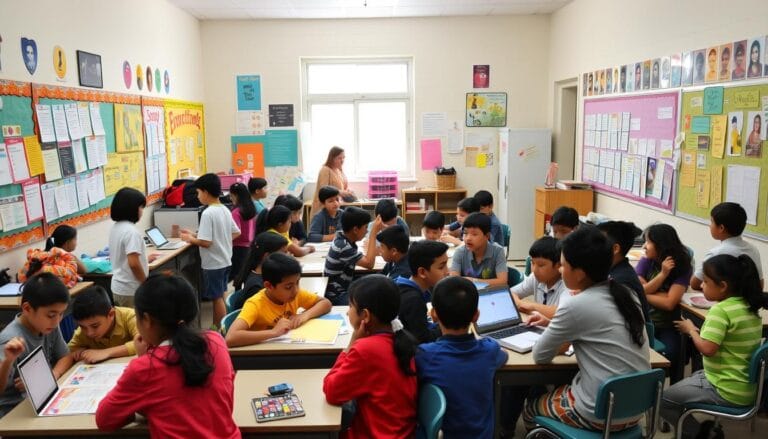How Does Homeschooling Work? A Complete Guide
Every parent wants the best for their child’s education. Traditional schools are getting tougher, leading more families to homeschool. In 2022, about 3.7 million students chose home-based learning, showing a big change in education.
Homeschooling offers a chance for personalized learning. Parents can tailor a homeschool curriculum to fit their child’s learning style and interests. This way, education meets each child’s unique needs.
The shift to homeschooling has been huge since COVID-19. It’s grown by 63%. Parents want more control over their kids’ education, worried about traditional schools. They seek learning experiences that fit their child better.
Homeschooling is more than an alternative; it’s a way to empower families. It lets them create learning paths that work for their child. This guide will help you understand homeschooling, whether you’re thinking about it or just curious.
We’ll cover everything from choosing a curriculum to legal rules. You’ll learn how to create a great home learning space. It will support your child’s growth in school and beyond.
Table of Contents
Understanding the Fundamentals of Homeschooling
Homeschooling is a strong choice for families, offering a chance to tailor learning. It’s becoming more popular as education changes. More parents want to match their kids’ learning needs and styles.
Recent trends show home learning is growing. About 1.7 million U.S. students were homeschooled in 2019-2020. This shows home education is a big and expanding part of learning.
What Defines Home Education
Home education breaks free from traditional classrooms. It lets parents design learning spaces that fit their kids. Homeschooling benefits include:
- Personalized curriculum design
- Flexible learning schedules
- One-on-one instructional attention
- Tailored educational approaches
The Growing Popularity of Homeschooling in America
The way we learn is changing. In 2020, about 3.7% of students were homeschooled, up from 2.2% in 1999. This shows more parents are looking for different ways to educate their kids.
“Homeschooling allows families to unlock their children’s unique potential through personalized learning experiences.”
Key Components of Home-Based Learning
Good homeschooling needs careful planning and dedication. Important parts include:
- Structured curriculum selection
- Consistent educational tracking
- Engagement in extracurricular activities
- Regular academic assessments
With 85% of homeschooling parents happy with their choice, it’s clear home learning has big benefits. It’s a great option for families who want to try something different.
How Does Homeschooling Work: Getting Started
Starting your homeschooling journey can seem daunting. But, with the right steps, you’ll find a rewarding path for your family. The first step is to prepare and research well.
Before you begin, think about these important steps:
- Research different homeschooling methods
- Understand your state’s legal requirements
- Assess your available time and resources
- Connect with local homeschool communities
The world of homeschool resources has grown a lot. Approximately 3.7 million students were homeschooled during the 2020-2021 school year. This shows homeschooling is becoming more popular.
“Homeschooling is not about perfection, but about creating a personalized learning experience for your child.” – Homeschool Advocate
Your homeschooling plan should fit your family’s needs. Think about these important points:
| Consideration | Details |
|---|---|
| Learning Style | Traditional, Montessori, Classical, Unschooling |
| Time Commitment | 3-5 hours daily of dedicated teaching |
| Resource Allocation | Budget for curriculum, supplies, potential tutoring |
With good planning and a variety of homeschool resources, you can make a rich learning experience. It will be tailored to your child’s needs and abilities.
Legal Requirements and State Regulations
Understanding homeschool laws can be tough, but it’s key for home education success. Laws differ by state, so knowing your local rules is crucial.
Parents need to focus on state rules for homeschooling. California shows how different options can be:
- Private school homeschooling
- Public charter programs
- Independent study options
- Creating a private home school
State-Specific Homeschool Laws
Every state has its own homeschool rules. In California, important laws include:
| Legal Requirement | Details |
|---|---|
| Compulsory Education | Children ages 6-18 must receive instruction |
| Instruction Time | Minimum 3 hours daily, 175 days per academic year |
| Private School Affidavit | Must be filed annually under Education Code Section 33190 |
Required Documentation and Records
Keeping accurate records is crucial for homeschooling families. California Education Code outlines what’s needed:
- Attendance registers
- Student academic progress records
- Curriculum documentation
Compliance and Reporting Requirements
“Knowledge of the law is the lantern that guides your homeschooling journey.”
California doesn’t require standardized tests for homeschoolers, but about 50% of families do tests. It’s important to keep up with law changes and use homeschool resources for compliance.
Use the California Department of Education’s helpline and local homeschool groups for help. They offer the latest on legal needs.
Choosing Your Homeschool Curriculum

Choosing the right homeschool curriculum can seem overwhelming. Parents have the freedom to create learning experiences that fit their children’s needs and styles.
It’s important to know how your child learns best. Some do well with pictures, others with sounds, and some with hands-on activities.
“Curriculum selection is about finding the perfect educational puzzle pieces for your child’s learning journey.”
Key Considerations for Curriculum Selection
- Assess individual learning styles
- Consider family budget constraints
- Evaluate long-term educational goals
- Remain flexible in curriculum choices
Homeschool curriculum options are vast. They range from complete programs to custom learning paths using various resources. Many families blend different methods for a personalized education.
| Curriculum Type | Pros | Considerations |
|---|---|---|
| Traditional Textbook | Structured learning | May limit creativity |
| Online Courses | Flexible scheduling | Requires technological access |
| Eclectic Approach | Customizable | Requires more planning |
Remember, successful homeschool curriculum selection is an ongoing process. Don’t hesitate to adjust your approach as you discover what works best for your child’s learning journey.
Creating an Effective Learning Environment
Turning your home into a great learning space is key for homeschooling success. With about 3.7 million students homeschooled in 2020-2021, a dedicated area for learning is more important than ever.
Designing Your Homeschool Classroom
Having a dedicated learning space can help with homeschooling. Here are some important things to think about when setting up your home classroom:
- Choose a quiet area with minimal distractions
- Ensure adequate lighting and comfortable seating
- Install shelves or storage units for educational materials
- Create a flexible workspace that can adapt to different learning activities
Organizing Educational Materials
Good homeschool schedules need well-organized resources. Here’s how to keep your learning materials in order:
- Use color-coded folders for different subjects
- Create digital and physical backup systems
- Establish a consistent filing method
- Regularly review and update your materials
Establishing Daily Routines
Consistency is key in homeschooling. Create homeschool schedules that mix structure with flexibility. Studies show that having a dedicated learning space helps kids focus and stay motivated.
“The best classroom is the one where you can explore and learn without fear of judgment.” – Unknown
Your homeschool environment should be lively, flexible, and fit your child’s learning style. Remember, homeschooling is about making learning fun and supportive in your own home.
Homeschool Teaching Methods and Approaches
Homeschool methods offer a wide range of educational approaches. These allow parents to tailor learning to their child’s needs. Each curriculum has its way of engaging and inspiring students.
Different homeschooling methods have their educational philosophies:
- Classical Education: Focuses on language and history. It has three stages:
- Grammar Stage: Emphasizes memorization and skill practice
- Dialectic Stage: Focuses on logic and reasoning
- Rhetoric Stage: Uses writing and speaking to apply knowledge
- Charlotte Mason Method: Based on 20 key principles. It:
- Stresses habit formation
- Uses oral narrations for younger students
- Introduces written narrations in upper grades
- Unit Study Approach: Combines multiple subjects in one learning module
- Montessori-Inspired Learning: Focuses on hands-on, self-directed learning
“The beauty of homeschooling lies in its flexibility to adapt educational methods to your child’s unique learning style.” – Homeschool Expert
When choosing homeschool methods, think about your family’s values and your child’s learning style. Many families mix different approaches. This creates an eclectic homeschool curriculum that grows with your child.
Successful homeschooling isn’t about finding the perfect method. It’s about being consistent, patient, and nurturing your child’s curiosity.
Managing Time and Creating Schedules
Creating effective homeschool schedules is key to successful home education. Families find that a structured yet flexible learning space boosts educational results and learning fun.
Homeschool schedules have perks that regular schools can’t offer. Parents can tailor learning to fit their kids’ natural learning styles and family life.
Designing Your Academic Calendar
Making a good academic calendar needs careful planning. Here are some important points:
- Start with a consistent morning routine
- Set core learning times from 9:00 AM to 12:00 PM
- Include flexible learning times
- Make room for unexpected learning chances
Balancing Academic and Extracurricular Activities
Homeschooling offers more than just classroom learning. It lets families mix learning with hobbies and social activities smoothly.
“Flexibility is the greatest strength of homeschooling – learning happens everywhere, not just at a desk.”
Flexible Learning Options
There are many ways to make your homeschool better:
- Block scheduling for deep dives into subjects
- Four-day school weeks
- Learning all year round
- Learning based on interests
Good homeschool schedules change as your family grows. Stay flexible and keep adjusting your plan to fit your kids’ learning needs.
Cost Considerations and Budget Planning

Understanding homeschooling costs is key for families thinking about homeschooling. Homeschooling can be cheaper than public school, but you need to plan your budget well.
The average homeschool expenses are $700 to $1,800 per child each year. This amount can change a lot based on your choices and resources.
Breakdown of Homeschool Expenses
| Expense Category | Estimated Annual Cost |
|---|---|
| Curriculum Materials | $350 – $750 |
| Learning Supplies | $150 – $300 |
| Field Trips | $100 – $250 |
| Extracurricular Activities | $100 – $500 |
Here are some smart ways to manage homeschool costs:
- Use free online homeschool resources
- Buy used curriculum materials
- Join homeschool co-ops to split costs
- Make use of library and community programs
“Homeschooling doesn’t have to break the bank. With careful planning, you can provide quality education while managing your budget effectively.”
Technology is important for homeschool resources. Plan for:
- Computer or tablet: $300 – $1,000 (one-time cost)
- Educational software: $50 – $200 annually
- High-speed internet: $40 – $100 monthly
Your homeschool costs can be adjusted to fit your budget. The main thing is to plan smart and use resources wisely.
Social Development and Extracurricular Activities
Homeschool socialization is a big concern for many. But, homeschooled kids have lots of chances to make friends and get involved in their community.
Homeschooling offers more than just classroom learning. Families can find many ways to help their kids grow socially and personally.
Building Social Connections
Homeschooled students can make real friends through different ways:
- Homeschool co-ops and learning groups
- Community classes and workshops
- Local sports teams
- Volunteer organizations
- Arts and music programs
Community Involvement Opportunities
“Socialization isn’t about sitting in a classroom, but about interacting with diverse groups and learning real-world skills.”
Getting involved in the community is great for homeschooled kids. About 80% of homeschool families see the value in socializing outside the home.
| Activity Type | Social Benefits | Typical Participation Rate |
|---|---|---|
| Sports | Team collaboration | 65% |
| Performing Arts | Creative expression | 45% |
| Community Service | Civic engagement | 55% |
Sports and Group Activities
Extracurricular activities are a big plus for homeschoolers. Homeschoolers often have more flexibility to pursue diverse interests than traditional school students.
From sports leagues to clubs, homeschooled kids can learn important social skills. The key is to be active and look for many chances to meet new people.
Conclusion
Homeschooling has changed a lot since the 1970s, growing from 15,000 students to over 2 million today. It offers a personalized learning experience that fits each child’s needs and learning style. This approach has become more popular than ever.
Studies show that homeschooled students often do better academically. They score 15 to 30 percentile points higher on tests and get better college GPAs. About 90% of homeschooling parents are very happy with their children’s education.
Homeschooling requires hard work and planning but offers great flexibility. It lets families spend more time together. About 60% of homeschooled kids join community activities, showing they are well-rounded.
Thinking about homeschooling? It’s not for everyone, but it can be a great choice. It lets you tailor education to your child’s needs. With the right planning, homeschooling can be a rewarding experience for everyone involved.








